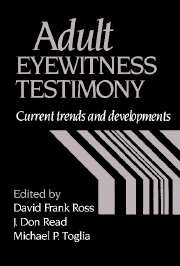Book contents
- Frontmatter
- Contents
- List of contributors
- Preface
- Part I Cognitive, physical and social processes and factors influencing eyewitness recall and identification
- 1 Reports of suggested memories: Do people truly believe them?
- 2 Memory source monitoring and eyewitness testimony
- 3 Understanding bystander misidentifications: The role of familiarity and contextual knowledge
- 4 Unconscious transference and lineup identification: Toward a memory blending approach
- 5 Earwitness evidence: Memory for a perpetrator's voice
- 6 Whole body information: Its relevance to eyewitnesses
- 7 Actual victims and witnesses to robbery and fraud: An archival analysis
- Part II Lineup construction and collection of testimony
- Part III Whom to believe? Distinguishing accurate from inaccurate eyewitnesses
- Name index
- Subject index
2 - Memory source monitoring and eyewitness testimony
Published online by Cambridge University Press: 04 August 2010
- Frontmatter
- Contents
- List of contributors
- Preface
- Part I Cognitive, physical and social processes and factors influencing eyewitness recall and identification
- 1 Reports of suggested memories: Do people truly believe them?
- 2 Memory source monitoring and eyewitness testimony
- 3 Understanding bystander misidentifications: The role of familiarity and contextual knowledge
- 4 Unconscious transference and lineup identification: Toward a memory blending approach
- 5 Earwitness evidence: Memory for a perpetrator's voice
- 6 Whole body information: Its relevance to eyewitnesses
- 7 Actual victims and witnesses to robbery and fraud: An archival analysis
- Part II Lineup construction and collection of testimony
- Part III Whom to believe? Distinguishing accurate from inaccurate eyewitnesses
- Name index
- Subject index
Summary
When called upon to testify, eyewitnesses must distinguish between memories of their experience of the event in question and memories of other sources of information about that event. The latter might include memories of their own or other people's descriptions of the event, memories of thoughts and fantasies related to the event (before or after its occurrence), and general knowledge and beliefs. Thus a question such as ‘Tell me what happened on the afternoon of Wednesday, June 24th, 1992” might serve as a retrieval cue for a wealth of memories in addition to those of the witness's own experience that fateful afternoon.
“Source monitoring” refers to the hypothetical cognitive processes by which people identify the sources of their recollections. Understanding such processes will allow us to specify the factors that lead people to misidentify memories from one source as memories from another (for example, mistake memories of postevent suggestions as memories of the event itself). This chapter begins with a summary of the source monitoring approach in general terms, followed by a review of evidence concerning the factors that affect the likelihood of source monitoring errors (see Johnson, Hashtroudi, & Lindsay, 1992, for a more extended treatment of these ideas). The next, and largest, section discusses research Johnson and I and others have conducted on the role of source monitoring processes in studies of eyewitness suggestibility. Subsequent sections examine related issues such as bystander misidentification and age-related changes in source monitoring skills.
- Type
- Chapter
- Information
- Adult Eyewitness TestimonyCurrent Trends and Developments, pp. 27 - 55Publisher: Cambridge University PressPrint publication year: 1994
- 56
- Cited by

